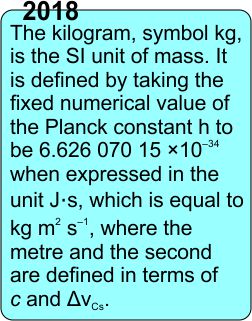“So what’s the next two steps?” Vinnie asks.
“I’m thinking a dose of the pink stuff and a glass of milk. That garlic calzone’s just not giving up.”
“Nah, we were talking about the new mass standard and how it uses a Kibble Balance protocol you said had three steps but you only got to the gravity-measuring step. You wanna talk to take your mind off your gut, do some more of that.”

“<burp-sigh> OK, assume we did an accurate measurement of gravity’s acceleration g right next to the Balance.” <pulling Old Reliable from its holster...> “Here’s the device in the protocol’s second step, ‘weighing mode’. Bottom to top we’ve got a permanent magnet A and a coil of wire B that’s hooked up to some electronics. The coil floats in the magnetic field because it’s carrying an electric current from that adjustable power source C. The balance’s test pan D rides on the coil and supports our target mass E. Up top, laser interferometer F keeps track of the test pan’s position. Got all that?”
“Mass goes in the pan, got it.”
“Good. You adjust the current through the coil until the interferometer tells you the test pan is floating motionless. Here’s where the electronics come into play. The same current goes through resistor RK, a quantum Hall effect device chilling in a magnetic field and a bath of liquid helium. Quantum math says its resistance is h/e², where e is the charge on an electron and h is Planck’s constant. Those’re both universals like Einstein’s lightspeed c. RK comes to 25812.807557 ohms. You remember the V-I-R diagram?”

“Once Ms Kendall drills it into your brain it’s there forever. Volts equals current in amps times resistance in ohms.”
“Yep. In the Kibble Balance we evaluate the coil’s balancing current by measuring the voltage drop across RK. The voltmeter uses a Josephson junction, another quantum thingie. At a voltage V the junction passes a small alternating current whose frequency is f=V/CJ, where CJ=h/2e. Count the frequency and you can calculate the voltage. DivideV by RK to get the current iW going through the resistor. Everything here meets the count-based, stable, reproducible-anywhere standard.”
“I suppose the w suffixes mean ‘weigh mode’ and m in the bottom equation is the mass. Makes sense that heavier masses need more current to float them. What’s G?”
“Hold on, I got another burp coming … <bo-o-o-O-O-ORP!>”
“Impressive.”
“Thanks, I suppose. G rolls up all those geometry factors — size, shape and power of the magnet and so forth — that you complained about when I said ‘motor-generator.’ We take care of that in the third step. Here’s the diagram for that.”

“Looks pretty much the same.”
“We took out the target mass and the power source, and see, there’s v-subscripts for ‘velocity mode.’ We move the coil vertically while
the atomic clock ticks and the interferometer tracks the pan’s position. That lets us calculate speed s. The coil moving through the magnetic field generates a voltage V=fvCj=sG. Because the geometry factor G is identical between modes, the linkage between coil speed and output power is exactly the same as the linkage between current and input power. That’s the middle equation — velocity-mode voltage divided by speed equals weighing-mode force divided by current.”
“That’s weird.”
“But true, and so elegant. Every variable in that equation save the mass comes from a high-accuracy, high-precision reproducible standard. That makes mass a measure-anywhere dimension, too. But wait, there’s more.”
“Too much math already.”
“Just a little more. Plug all these equations together and you get the bottom one. That’s exciting.”
“Doesn’t look exciting to me.”

“It goes back to the universal constants thing. The first factor in th middle is a ratio of count-derived quantities. Plug the quantum definitions into the second factor and you get CJ²/RK=(h²/4e²)(e²/h)=h/4. What that says is mass is expressible in units of Planck’s constant. That’s deep stuff! What’s exciting is that the standards people used that result in defining the kilogram.”
“Well, blow me down. And one more of your garlic burps or any more math just might.”
~~ Rich Olcott

